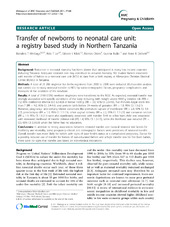| dc.contributor.author | Mmbaga, Blandina T. | en_US |
| dc.contributor.author | Lie, Rolv Terje | en_US |
| dc.contributor.author | Kibiki, Gibson S. | en_US |
| dc.contributor.author | Olomi, Raimos | en_US |
| dc.contributor.author | Kvåle, Gunnar | en_US |
| dc.contributor.author | Daltveit, Anne Kjersti | en_US |
| dc.date.accessioned | 2012-01-23T13:26:04Z | |
| dc.date.available | 2012-01-23T13:26:04Z | |
| dc.date.issued | 2011-10-04 | eng |
| dc.Published | BMC Pregnancy and Childbirth 2011, 11:68 | en |
| dc.identifier.issn | 1471-2393 | |
| dc.identifier.uri | https://hdl.handle.net/1956/5505 | |
| dc.description.abstract | Background: Reduction in neonatal mortality has been slower than anticipated in many low income countries including Tanzania. Adequate neonatal care may contribute to reduced mortality. We studied factors associated with transfer of babies to a neonatal care unit (NCU) in data from a birth registry at Kilimanjaro Christian Medical Centre (KCMC) in Tanzania. Methods: A total of 21 206 singleton live births registered from 2000 to 2008 were included. Multivariable analysis was carried out to study neonatal transfer to NCU by socio-demographic factors, pregnancy complications and measures of the condition of the newborn. Results: A total of 3190 (15%) newborn singletons were transferred to the NCU. As expected, neonatal transfer was strongly associated with specific conditions of the baby including birth weight above 4000 g (relative risk (RR) = 7.2; 95% confidence interval (CI) 6.5-8.0) or below 1500 g (RR = 3.0; 95% CI: 2.3-4.0), five minutes Apgar score less than 7 (RR = 4.0; 95% CI: 3.4-4.6), and preterm birth before 34 weeks of gestation (RR = 1.8; 95% CI: 1.5-2.1). However, pregnancy- and delivery-related conditions like premature rupture of membrane (RR = 2.3; 95% CI: 1.9- 2.7), preeclampsia (RR = 1.3; 95% CI: 1.1-1.5), other vaginal delivery (RR = 2.2; 95% CI: 1.7-2.9) and caesarean section (RR = 1.9; 95% CI: 1.8-2.1) were also significantly associated with transfer. Birth to a first born child was associated with increased likelihood of transfer (relative risk (RR) 1.4; 95% CI: 1.2-1.5), while the likelihood was reduced (RR = 0.5; 95% CI: 0.3-0.9) when the father had no education. Conclusions: In addition to strong associations between neonatal transfer and classical neonatal risk factors for morbidity and mortality, some pregnancy-related and demographic factors were predictors of neonatal transfer. Overall, transfer was more likely for babies with signs of poor health status or a complicated pregnancy. Except for a possibly reduced use of transfer for babies of non-educated fathers and a high transfer rate for first born babies, there were no signs that transfer was based on non-medical indications. | en_US |
| dc.language.iso | eng | eng |
| dc.publisher | BioMed Central | eng |
| dc.relation.ispartof | <a href="http://hdl.handle.net/1956/6570" target="blank">Pregnancy and perinatal health outcomes in Northern Tanzania: a registry based study</a> | eng |
| dc.rights | Attribution CC BY | eng |
| dc.rights.uri | http://creativecommons.org/licenses/by/2.0/ | eng |
| dc.title | Transfer of newborns to neonatal care unit: a registry based study in Northern Tanzania | en_US |
| dc.type | Peer reviewed | |
| dc.type | Journal article | |
| dc.description.version | publishedVersion | en_US |
| dc.rights.holder | Copyright 2011 Mmbaga et al; licensee BioMed Central Ltd. | |
| dc.identifier.doi | https://doi.org/10.1186/1471-2393-11-68 | |
| dc.identifier.cristin | 862730 | |
| dc.subject.nsi | VDP::Medical disciplines: 700::Health sciences: 800::Health service and health administration research: 806 | eng |

